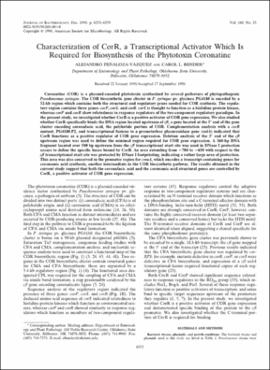| dc.contributor.author | Penaloza-Vazquez, Alejandro | |
| dc.contributor.author | Bender, Carol L. | |
| dc.date.accessioned | 2015-10-16T20:47:42Z | |
| dc.date.available | 2015-10-16T20:47:42Z | |
| dc.date.issued | 1998-12 | |
| dc.identifier | okds_Bender_JB_1998-12.pdf | |
| dc.identifier.citation | Penaloza-Vazquez, A., & Bender, C. L. (1998). Characterization of CorR, a transcriptional activator which is required for biosynthesis of the phytotoxin coronatine. Journal of Bacteriology, 180(23), 6252-6259. https://doi.org/10.1128/JB.180.23.6252-6259.1998 | |
| dc.identifier.uri | https://hdl.handle.net/11244/19769 | |
| dc.description.abstract | Coronatine (COR) is a plasmid-encoded phytotoxin synthesized by several pathovars of phytopathogenic Pseudomonas syringae. The COR biosynthetic gene cluster in P. syringae pv. glycinea PG4180 is encoded by a 32-kb region which contains both the structural and regulatory genes needed for COR synthesis. The regulatory region contains three genes: corP, corS, and corR. corS is thought to function as a histidine protein kinase, whereas corP and corR show relatedness to response regulators of the two-component regulatory paradigm. In the present study, we investigated whether CorR is a positive activator of COR gene expression. We also studied whether CorR specifically binds the DNA region located upstream of cfl, a gene located at the 5* end of the gene cluster encoding coronafacic acid, the polyketide portion of COR. Complementation analysis with a corR mutant, PG4180.P2, and transcriptional fusions to a promoterless glucuronidase gene (uidA) indicated that CorR functions as a positive regulator of COR gene expression. Deletion analysis of the 5* end of the cfl upstream region was used to define the minimal region required for COR gene expression. A 360-bp DNA fragment located over 500 bp upstream from the cfl transcriptional start site was used in DNase I protection assays to define the specific bases bound by CorR. An area extending from 2704 to 2650 with respect to the cfl transcriptional start site was protected by DNase I footprinting, indicating a rather large area of protection. This area was also conserved in the promoter region for cmaA, which encodes a transcript containing genes for coronamic acid synthesis, another intermediate in the COR biosynthetic pathway. The results obtained in the current study suggest that both the coronafacic acid and the coronamic acid structural genes are controlled by CorR, a positive activator of COR gene expression. | |
| dc.format | application/pdf | |
| dc.language | en_US | |
| dc.publisher | American Society for Microbiology | |
| dc.rights | This material has been previously published. In the Oklahoma State University Library's institutional repository this version is made available through the open access principles and the terms of agreement/consent between the author(s) and the publisher. The permission policy on the use, reproduction or distribution of the material falls under fair use for educational, scholarship, and research purposes. Contact Digital Resources and Discovery Services at lib-dls@okstate.edu or 405-744-9161 for further information. | |
| dc.title | Characterization of CorR, a transcriptional activator which is required for biosynthesis of the phytotoxin coronatine | |
| osu.filename | okds_Bender_JB_1998-12.pdf | |
| dc.description.peerreview | Peer reviewed | |
| dc.identifier.doi | 10.1128/JB.180.23.6252-6259.1998 | |
| dc.description.department | Entomology and Plant Pathology | |
| dc.type.genre | Article | |
| dc.type.material | Text | |
